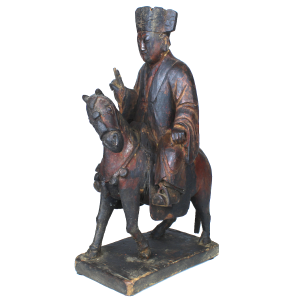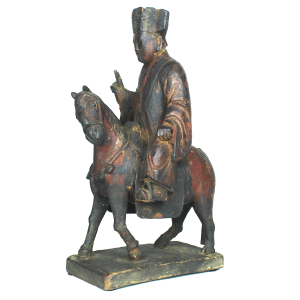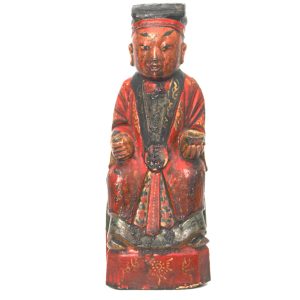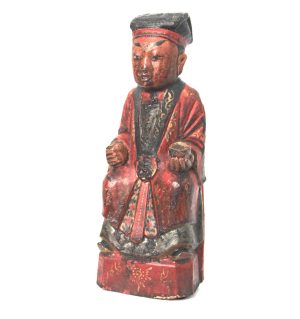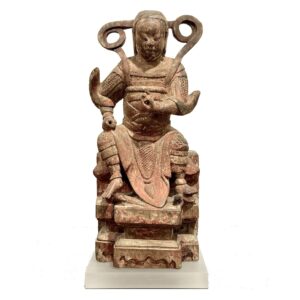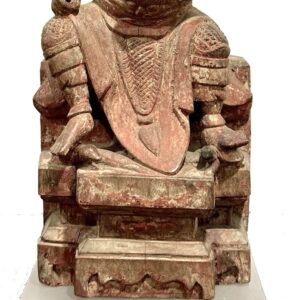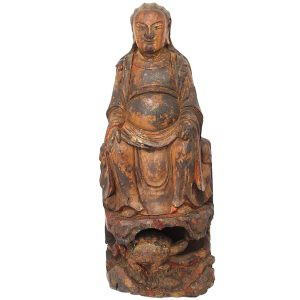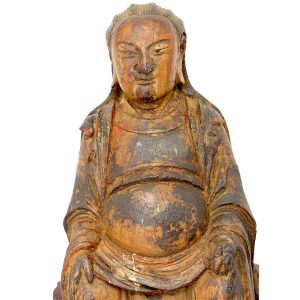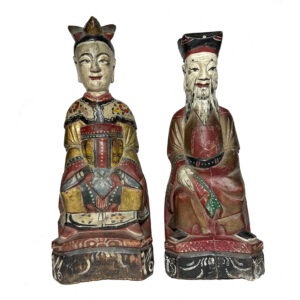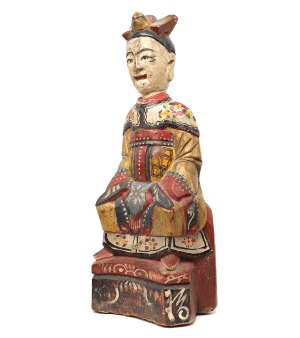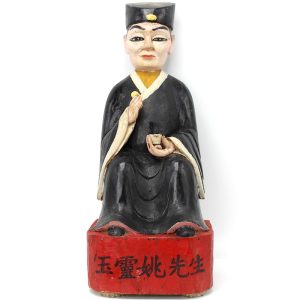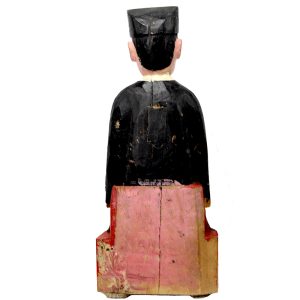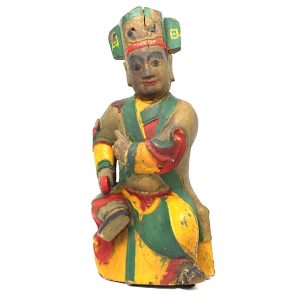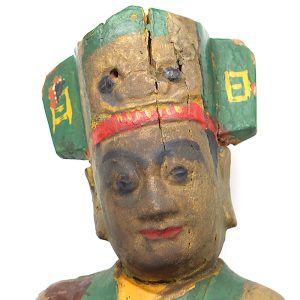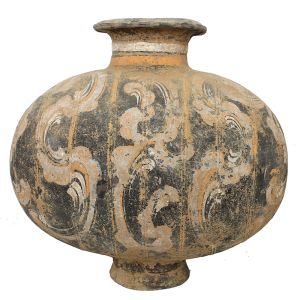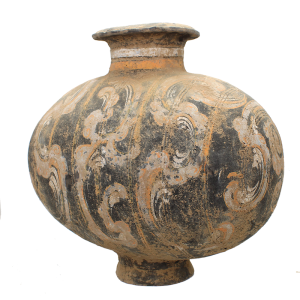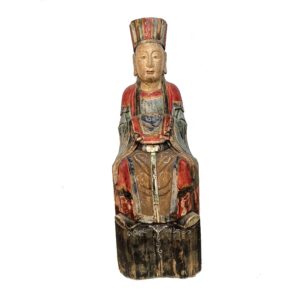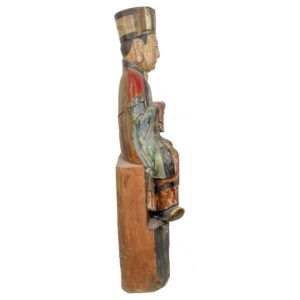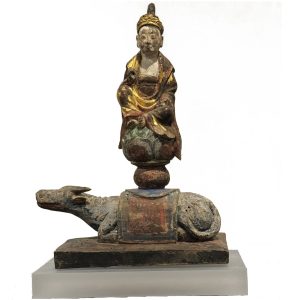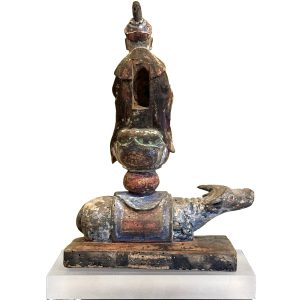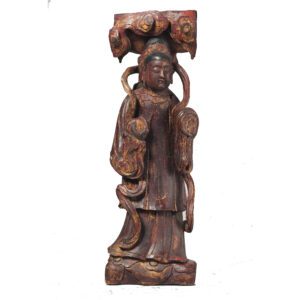Showing 49–60 of 69 results
-
Sale!


$795.00 Original price was: $795.00.$595.00Current price is: $595.00.
H: 13″ W: 4″ D: 7″ | FREE SHIPPING WITHIN CONTINENTAL U.S.
Taoist priest wearing a winged hat with a taotie warning against excess, and hands in the Sword Gesture used to cast out evil and offer blessings. Often on horses, priests were models of morality reflecting the Way of the Tao stressing harmony and oneness with nature.
-
Sale!


$295.00 Original price was: $295.00.$195.00Current price is: $195.00.
H: 7.25″ W: 2.75″ D :2″ | FREE SHIPPING WITHIN CONTINENTAL U.S.
Colorful Taoist priest carving holding a cup with the Elixir of Life granting eternal life. Red is the color of fu to bring into the home divine favors. Whimsically painted face and raised lacquer decorations, it was consecrated and originally placed on a home altar.
-
Sale!


$1,250.00 Original price was: $1,250.00.$975.00Current price is: $975.00.
H: 15.25″ W: 6.75″ D: 6.75″ |CALL 213-568-3030 OR EMAIL [email protected] FOR SHIPPING
Zhenwu (Perfected Warrior) one of most important and powerful Taoist deities, is revered for magical powers to suppress demonic forces. Forceful wood provincial image for personal devotion reflecting his iconography: on throne, bare feet resting on snake and tortoise, celestial scarf and maille armor.
-
Sale!


$575.00 Original price was: $575.00.$495.00Current price is: $495.00.
H: 13″ W: 5″ D: 4.8″ | FREE SHIPPING WITHIN CONTINENTAL U.S.
Provincial carving of Zhenwu the Perfected Warrior, one of the most popular Taoist deities in the Ming/Qing dynasties, iconically shown standing on a snake and turtle, symbolizing those over whom he presides.
-
Sale!


$785.00 Original price was: $785.00.$625.00Current price is: $625.00.
H: Tudi Gong: 11.75″. Tudi Po 12.37″ | CALL 213-568-3030 OR EMAIL [email protected] FOR SHIPPING.
This happy benevolent couple are Taoist Earth God Tudi Gong and his wife Tudi Po placed on a home altar to assure an abundant harvest. Referred to as “Grandpa” and “Grand Ma” they wear vibrant Mandarin official’s attire, him with a mandarin square with a bird, and her with a phoenix headdress.
-
Sale!


$625.00 Original price was: $625.00.$425.00Current price is: $425.00.
H: 8.25″ W: 3.125″ D: 2.25″ | FREE SHIPPING!
This Kitchen God and his Wife is posed as streamlined virtual mirror-images and fashioned with a general quality relying on paint rather than deep carving for details. They sit on backless chairs on a plinth, with simplified gold officials’ robes with long color sashes, and well-carved black and gilt head gear. The wife’s face is smooth, generalized and the male face has a more deeply carved surface and painted highlights.
-
Sale!


$215.00 Original price was: $215.00.$155.00Current price is: $155.00.
Ht: 14.75” W: 7.75” D: 4” | FREE SHIPPING WITHIN CONTINENTAL U.S.
Taoist priest in formal attire holding a cup with the elixir of health and longevity and small ingot symbolizing wish for prosperity and wealth. Characters on base are his name and the mythical “turtle spirit” that symbolizes longevity,
-
Sale!


$395.00 Original price was: $395.00.$295.00Current price is: $295.00.
H: 13.6 ” W: 7″ D: 5.5″ | FREE SHIPPING WITHIN CONTINENTAL U.S.
Taoist priest or shaman with a double-winged hat with a mythical taotie as a warning against greed and excess. His left hand in the Sword Gesture to cast out evil and right holding a tael symbolizing wealth and good fortune
-
Sale!


$2,150.00 Original price was: $2,150.00.$1,785.00Current price is: $1,785.00.
H: 11.75” W: 12.25” CALL 213-568-3030 OR EMAIL [email protected] FOR SHIPPING.
Families placed cocoon jars with auspicious designs containing magical mixtures of mulberry leaves in tombs for souls of the departed to drink for a transformative afterlife. Ovoid shaped, it rests on a trumpet-shaped foot decorated with elegant cloud scrolls and circular “eye” motifs.
-
Sale!


$3,950.00 Original price was: $3,950.00.$3,400.00Current price is: $3,400.00.
H: 34″ W: 11″ D: 8″ | CALL 213-568-3030 OR EMAIL [email protected] FOR SHIPPING.
This masterfully carved and painted 18th century statue of a Taoist priest/official wears elaborate robes and a hat. His well-articulated face has strong features and solemn gaze, flanked by pendulous ears, the sign of a wise man. This exceptional image deserves the appropriate placement to optimize its outstanding presence.
-
Sale!


$885.00 Original price was: $885.00.$725.00Current price is: $725.00.
H: 10.25″ W: 7.5″ D: 3.75″ | FREE SHIPPING WITHIN CONTINENTAL U.S.
Rare provincial carving of Guanyin on an ox reflecting the concept of bodhisattva reverence for “draft animals” (beasts of burden) who were integral to rural daily and agricultural activities in Chinese Popular Religion, Buddhism and Taoism.
-
Sale!

$3,200.00 Original price was: $3,200.00.$2,600.00Current price is: $2,600.00.
H: 31″ W: 11″ D: 6 1/2″| CALL 213-568-3030 OR EMAIL [email protected] FOR SHIPPING.
Exquisite carved Taoist Queen Mother of the West Jade Maiden attendant who carries a peach of immortality grown in the Queen’s Garden. These fruits blossom every 3,000 years and are served at her famous banquet in the Western Paradise.
End of content
End of content

